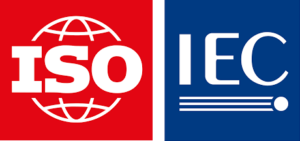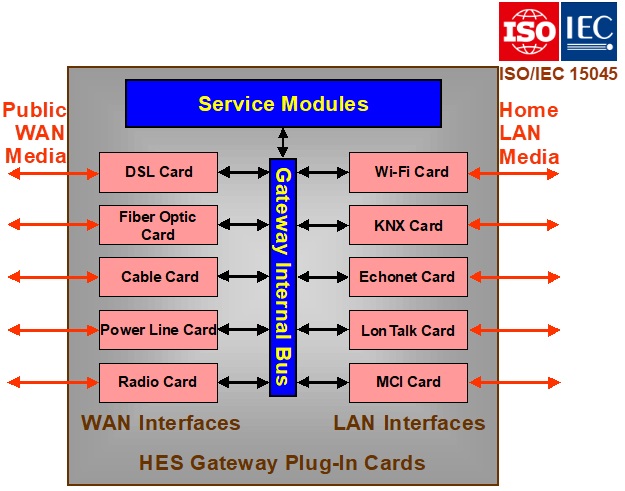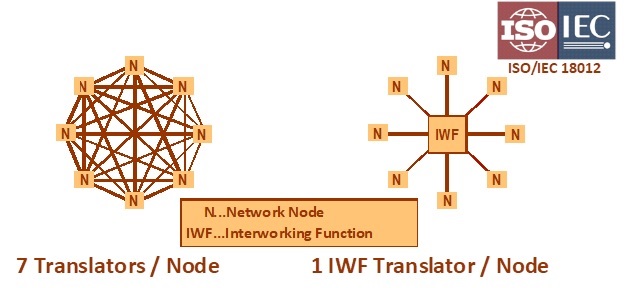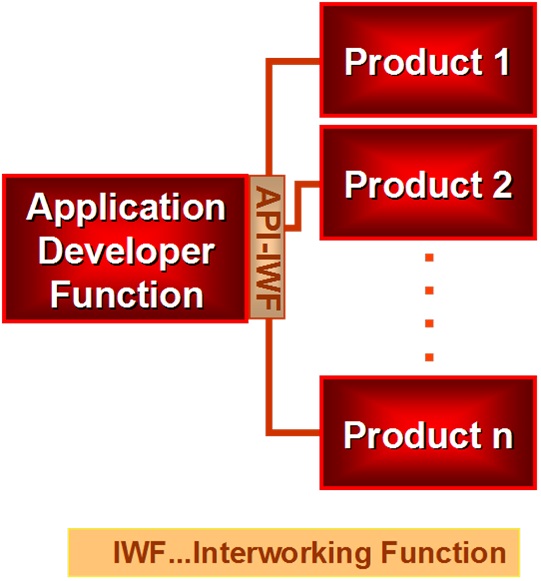This is the seventh article in a series that premiered in November 2021 on international standards for energy management. These standards support the transformation of the power grid from centralized generation to distributed energy resources including local solar, wind, and stored energy in homes and buildings.
 These are voluntary industrial standards developed to promote world trade by a committee I chair for ISO1 and IEC2. They are part of a family of standards for interconnected consumer electronics (home automation) called the “Home Electronic System” (HES)3. I welcome your comments and participation in developing these standards; please visit kenwacks.com for contact data.
These are voluntary industrial standards developed to promote world trade by a committee I chair for ISO1 and IEC2. They are part of a family of standards for interconnected consumer electronics (home automation) called the “Home Electronic System” (HES)3. I welcome your comments and participation in developing these standards; please visit kenwacks.com for contact data.
The Home Sentry
My recent ASHB Journal articles have focused on the benefits of local energy management using the international standard Energy Management Agent (EMA). As solar panels, wind turbines, energy storage, and associated controllers become more practical and cost-effective, some homes and buildings may not need power from the grid. For now we are planning a hybrid energy system with generation done locally, in a neighborhood microgrid, and from a grid supplied by a public utility or an energy aggregator.
With a hybrid system it may not be economical or desirable to supply power to some appliances at times when power is expensive or only available from polluting sources. Therefore, the EMA becomes a key element for helping consumers to choose:
- Which electricity supply options to select,
- When to use this power, and
- Which appliances including electric vehicle (EV) chargers to operate.
An effective EMA needs a link between the home or building and the outside network for access to data about external power sources (such as price and fuel type). This article introduces the HES Gateway as the “sentry” that enables this access while protecting the occupants and connected appliances.
The HES Gateway: beyond communications
The ISO/IEC 15045 series of international standards specifying the HES Gateway extends the conventional communications gateway that interconnects a local network (called a LAN – Local Area Network) to an external network (called a WAN – Wide Area Network) with some unique features. These additional gateway features are options that could be implemented with modular elements. Manufacturers might offer a variety of gateways with different combinations of optional modules to provide the functions summarized here.
A LAN in a house is often called a HAN: Home Area Network. This term is used in the ISO/IEC 15045 HES Gateway series and in this article.
The HES Gateway features
A communications gateway enables an interconnection between dissimilar networks. Since the late 20th century, communications engineers have organized digital communication networks into functional layers according to the OSI (Open Systems Interconnect) reference model, ISO/IEC 7498-14. OSI specifies seven layers for a communications network, where Layer 1 is the physical connection, while Layer 7 is the format (syntax) of a logical structure to encode messages for transmission. An OSI communications interface receiving a message is responsible for decoding the physical layer signals (e.g., electrical voltage, radio frequency, or fiber-optic light pulses) into the sender’s message (“set temp to 70 degrees F”). Interconnecting dissimilar networks may require adapting to a different message format or language and a different physical signaling method. A “communications gateway” is a device for linking two dissimilar networks (“A” and “B”) by re-constructing the message from the “A”-side physical signals, translating it into a message understood by the B side, and encoding it into the physical signals carried by the “B” side. The HES Gateway does this by linking a WAN outside the home or building with a HAN to provide traditional gateway services, plus much more. The HES Gateway provides these additional services:
- Support for multiple HANs
- Support for cybersecurity protection
- Support for applications
- Support for interconnected gateways
- Support for interoperability among competing products
As home automation evolved from a hobby to an industry, there were attempts nationally and internationally to create standards for a uniform communications infrastructure to interconnect devices such as sensors, actuators, controllers, and user interfaces. These standards were completed and were technically sound. However, they were not adopted. Instead, the market is fragmented into specialized networks such as KNX, LonTalk, Wi-Fi, Zigbee, Z-Wave, etc. With this reality, HES focuses on enabling interoperability among disparate HANs and devices using these HANs.
The HES Gateway structure
Figure 1 shows the functional components of a generic HES Gateway. The various interface cards are specialized for each WAN and HAN to translate messages using an HES Gateway feature called the Interworking Function, which is described in the following section on interoperability.
The core functionality of the HES Gateway is embodied in Service Modules. A Service Module contains instructions for processing Service Data for protocol translation, cybersecurity protections, application operation, and any other responsibilities assigned to the HES Gateway. These instructions are handled by the following components of a Service Module:
- Service Objects: these represent elements of an application that may be hosted on the HES Gateway. The lexicon of Service Objects is contained in ISO/IEC 18012-35.
- A Binding Map: this is a set of instructions for processing, translating, and routing messages from one network (HAN or WAN) to another network.

Figure 1 – HES Gateway structure
Standards are written to provide specifications for models, architectures, interfaces, and communication protocols while offering flexibility for manufacturers to create significant product differences. Manufacturers can differentiate their HES Gateway offerings from competitors by choosing, for example:
- Which HES Gateway functions to include from among the options in the standards.
- Whether to package the HES Gateway with other consumer electronics.
- The user interface for the consumer or installer to configure the HES Gateway.
These standards encourage a diverse market for HES Gateway products. ISO/IEC 15045-4-16 and subsequent parts7 specify classes of HES Gateway configurations that range in capabilities and complexity:
- Class 1: Simple gateway
Manages and controls the communications between two HANs or one HAN and one WAN within one housing by using HES Common Language Direct PDU Exchange (HES-CLDPE, described below under interoperability).
- Class 2: Complex integral gateway
Manages and controls the communications among three or more HANs and WANs within one housing by using HES-CLDPE.
- Class 3: Complex modular gateway system
Manages and controls the communications among interoperable modular components, possibly provided by multiple manufacturers, via an Internet event bus by using the HES Common Language Internal Protocol (HES-CLIP, described below under interoperability).
- Class 4: Interconnected gateway system
Manages and controls the communications between more than one HES Gateway system so that they operate equivalently to a single HES Gateway system.
The primary function of the gateway is a communications interface. Some commercial home automation systems are being developed around a platform that acts as a communications hub and a host for controlling applications. The HES Gateway includes the option for embedding Service Modules that support applications, so the HES Gateway can be configured as a platform both for communications and for applications. Applications such as energy management could be hosted by the HES Gateway, as specified in ISO/IEC 15045-5-18 and ISO/IEC 15045-5-29.
Gateways are embedded in many products ranging from set-top boxes to Internet access equipment, to monitored security systems, and to smart TVs. A hallmark of an automated house is integration to deliver whole-home services. For example, a home theater room might include co-ordination among the entertainment equipment, shade control, and lighting. ISO/IEC 15045-1 specifies the interconnections and co-ordination among multiple HES Gateways in a home or building.
An important feature of the HES Gateway is the provision for interoperability among a variety of products that may not be using the same communications protocol or messaging format. The HES standards that facilitate interoperability are described in the next section.
Interoperability challenges
Many years ago the ISO/IEC committee developing the HES family of standards planned to include a uniform command set and device interfaces that were network-independent. Because of competitive market pressures, incompatible home networks were developed and are still being sold and installed. Therefore, the HES Gateway has been extended from a traditional communications interface between local and wide area networks to providing interconnections between dissimilar local networks, as illustrated on the right side of Figure 1.
Also, the HES Gateway enables interoperation among products never designed for compatibility and possibly operating on different home networks. The ISO/IEC 1801210 series specifying product interoperability makes it possible for devices from different companies to work together. These products support a diversity of applications such as entertainment, lighting, networked appliances, and energy management.
HES Gateway support for Interoperability
The HES Gateway provides a translation mechanism that product designers can use to ensure interoperability among applications. This translation is enabled by the Interworking Function (IWF). The IWF consists of a lexicon of objects for home system elements (switches, sensors, actuators, etc.) and a communications protocol for these objects to issue event notices that report a significant change-of-state. The message format for these notices is called the HES Common Language Message Exchange (CLME). The CLME messages are carried on the HES Gateway internal bus, which is specified as either of two configurations:
– HES Common Language Internal Protocol (HES-CLIP)
- Based on Internet and Ethernet protocols.
- Functions as a private local Internet.
- Intended to provide interoperability among modules supplied by multiple manufacturers.
– HES Common Language Direct PDU Exchange (HES-CLDPE)
- A family of protocols and electronic signals that supports operation between modular logical elements.
- Typically supplied by one manufacturer for integrated manufacturing.
We identified two fundamentally divergent methods for achieving interoperability among systems designed for different communication protocols with different message sets.
As shown in Figure 2 each node representing an appliance or system controller may be on a separate incompatible communications network. On the left a message translation between each pair of nodes is required for interoperation. So each node needs to understand different message sets from seven other nodes. On the right each message is translated into a single common message set we call the HES Common Language Message Exchange (HES-CLME). The communications among different protocols is handled by the IWF to facilitate interoperation.

Figure 2 – A standard for interoperability
Manufacturers may design products for interoperability by incorporating the HES IWF. The IWF consists of objects as logical elements representing components such as lamps, dimmers, switches, and sensors found in a lighting control application. These objects are cataloged in a lexicon specified by ISO/IEC 18012-311. Objects interact via messages called event notifications specified in ISO/IEC 18012-412. Standardized objects and event messages enable interoperability without impeding the ability of products to include unique functions and unique user interface designs.
By using the IWF, manufacturers are relieved from determining how to communicate with products from other makers. The HES Gateway offers manufacturers the flexibility of moving the IWF message handling upstream from the product into an HES Service Module within the HES Gateway. The firmware in this Service Module connects product actions to and from IWF messages using an HES Binding Map. The manufacturer would be responsible for supplying the Service Module firmware with the product so the firmware is uploaded into the HES Gateway when the consumer installs the product.
The interoperability standards have direct applicability to application programming interfaces (APIs). The Interworking Function could be the basis for standard APIs incorporated into products. A standards-based approach for APIs can benefit companies in the apps business. These companies have identified business opportunities for developing clever applications that can be installed in a variety of products. However, each target product requires a custom API. This is because products are designed using a variety of operating systems, communication protocols, and interfaces. The ISO/IEC 18012 series can be applied to achieve standard APIs, as shown in Figure 3.

Figure 3 – Common API using the Interworking Function
APIs can expand business for consumer electronics companies, developers of home system products, and for API add-on third-party developers. All can benefit by adopting standard APIs enabled by the IWF specified in the ISO/IEC 18012 series. The manufacturer and the third-party developers become invested in the product success by maintaining customer attention with new features. Ultimately this can keep customers focused on the product, extend the product life, and expand the brand and the market.
HES Gateway cybersecurity
The ISO/IEC 15045-3 series specifies features for an HES Gateway to provide cybersecurity services for homes and buildings. These services are intended to protect user data, privacy, and safety. Data protection is a growing challenge as devices are designed with access to Internet services. Such access makes these devices targets for data theft, reprogramming to create mayhem, and launching platforms for malware bots (Internet robots) that attack other devices. The next article in this series on international standards for energy management explores the cybersecurity features in the HES Gateway.
1. ISO is the International Organization for Standardization, founded in 1947, www.iso.org.
2. IEC is the International Electrotechnical Commission, founded in 1906, www.iec.ch.
Both ISO and IEC are headquartered in Geneva, Switzerland.
3. The Home Electronic System (HES) is the name of the international standards committee officially designated as ISO/IEC JTC 1/SC 25/WG 1:
JTC 1 = Joint Technical Committee 1, entitled Information Technology
SC 25 = Subcommittee 25, entitled Interconnection of Information Technology Equipment
WG 1 = Working Group 1, entitled Home Electronic System
4. ISO/IEC 7498-1:1994, Information Technology — Open Systems Interconnection — Basic Reference Model: The Basic Model
5. ISO/IEC 18012-3, Information technology – Home Electronic System (HES) – Guidelines for product interoperability – Part 3: Lexicon
6. ISO/IEC 15045-4-1, Information Technology – Home Electronic System (HES) Gateway – Part 4-1: HES gateway structural class and module requirements
7. ISO/IEC 15045-4-2, Information Technology – Home Electronic System (HES) Gateway – Part 4-2: Simple HES gateway
ISO/IEC 15045-4-3, Information Technology – Home Electronic System (HES) Gateway – Part 4-3: Complex integral HES gateway
ISO/IEC 15045-4-4, Information Technology – Home Electronic System (HES) Gateway – Part 4-4: Complex modular HES gateway
ISO/IEC 15045-4-5, Information Technology – Home Electronic System (HES) Gateway – Part 4-5: Interconnected HES gateways
8. ISO/IEC 15045-5-1, Information Technology – Home Electronic System (HES) – HES gateway, Application services, Part 5-1: Overview, foundation, and requirements
9. ISO/IEC 15045-5-2, Information Technology – Home Electronic System (HES) – HES gateway, Application services, Part 5-2: Energy management and measuring application (EMMA)
10. ISO/IEC 18012-1:2004, Information technology – Home Electronic System (HES) – Guidelines for product interoperability – Part 1: Introduction
ISO/IEC 18012-2:2012, Information technology – Home Electronic System (HES) – Guidelines for product interoperability – Part 2: Taxonomy and application interoperability model
11. ISO/IEC 18012-3, Information technology – Home Electronic System (HES) – Guidelines for product interoperability – Part 3: Lexicon [In progress]
12. ISO/IEC 18012-4, Information technology – Home Electronic System (HES) – Guidelines for product interoperability – Part 4: Event encoding [In progress]
© Copyright 2022 Kenneth P. Wacks
Dr. Kenneth Wacks has been a pioneer in establishing the home systems industry. He delivers clear and practical advice to manufacturers and energy companies worldwide on business opportunities, network alternatives, and product developments in IoT and AI for home and building systems. The United States Department of Energy appointed him to the GridWise® Architecture Council to guide the electric industry toward smart grids. For further information, please contact Ken at +1 781 662-6211; [email protected]; www.kenwacks.com.


